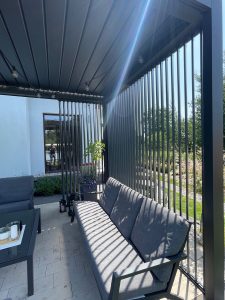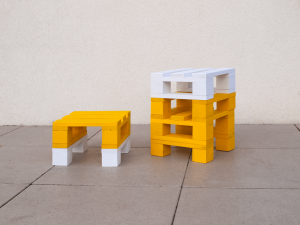
Vertical or horizontal external blinds - which solution should I choose?
Are you planning to enclose the side walls of a terrace, balcony or gazebo? See what to choose: movable vertical or horizontal external blinds.
Movable external blinds are a modern way of building up the side walls of a terrace, balcony or gazebo. They effectively protect from the sun, wind, shield from cold and moisture. You adjust them manually, setting the clearance from fully open to completely closed.
For reasons of functionality, side wall cladding with movable boards, is of growing interest. However, not everyone knows that installing these covers can be done in two ways. Find out the differences between horizontal and vertical blinds.
Vertical external blinds

Vertical external blinds are an elegant solution that pulls the body of the building upwards. They are perfect for modern building arrangements. You can use them to cover terrace walls, and they are also perfect for balcony development.
If you like vertical installation - aluminium laths are the best choice. These will allow you to build higher - the aluminium slats can be longer. You can use them to build up to 250 cm high. See here,How the installation of external vertical blinds looks like on YouTube.
Pros: Vertical blinds are elegant and look designer. They will lend a modern touch to your built-in. They are fully movable and easy to clean. Aluminium ones will not require maintenance. They do not need to be mounted on a frame.
Disadvantages: You will not fit wooden blinds vertically. They will pucker, which will affect the function of the mechanism for moving boards. Vertical slats should be aluminium. They are lighter and even a long aluminium lamella will not bend under its weight.
Horizontal external blinds

Horizontal blinds are suitable for all types of buildings. They will add a cosy touch to a built-in terrace or balcony. They will also look great on a gazebo. They are mounted on movable brackets on the frame. They can also be fixed permanently at an angle. Such laths will be great for shed or terrace walls that do not require mobility. They will also make excellent fencing elements.
Pros: Horizontal laths can be either aluminium or wood. Like the vertical ones, they are fully movable and you can fill any space with them (given the frame, of course).
Disadvantages: Horizontal laths should be mounted on a frame. They can be either wooden or aluminium. Wooden blinds, however, have greater length restrictions. You can safely install 110 cm long boards. Aluminium laths - 200 cm. Planks that are too long will warp over time and this should be taken into account. See,How to install horizontal external blinds on YouTube.
External blinds in wood or aluminium
Selection It is, of course, up to you. Wooden blinds are beautiful and slightly cheaper, but they do have their limitations. The boards must not be too long and they need to be maintained periodically. That is, cleaned and protected from pests and weather.
Aluminium is lighter and offers slightly more options. For example, vertical mounting. It does not require frequent maintenance and is more weather resistant. However, it is slightly more expensive than wood.
If you are choosing built-in blinds and are finding it difficult to make a choice, we are happy to help! Contact us and we will advise you on the optimal solution. Call us: + 48 530 336 595













